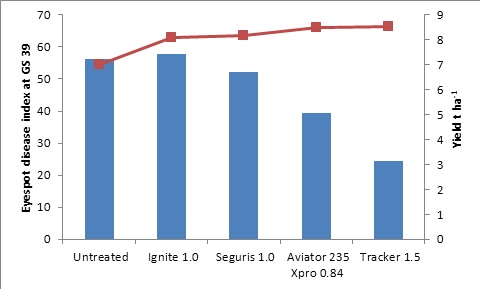
As the growing season gathers pace, Dr Rumiana Ray of Nottingham University warns growers against complacency to eyespot and advises those in high eyespot risk situations to get out into their crops and look carefully for any signs of the disease.
“The cold and wet spring has increased the risk of eyespot lesions penetrating and establishing on the stems, and if May is wet, the risk of developing severe disease will increase so it is essential to ensure that stems are protected,” she says.
“Assessments now of crops on a field by field basis are more important than ever; ensure that crops are walked thoroughly at growth stages 31-32, to identify early signs of the disease.”
Identifying eyespot
“The most obvious signs are small, brown eye-shaped lesions with a dark centre on the outer leaf sheaths at the base of the stem at soil level. Eyespot at GS 25/30 is difficult to distinguish from sharp eyespot; the difference between them is that sharp eyespot lesions are well defined with dark edged borders, the centre of the lesion is pale and often rotted. The most important early sign of severe eyespot is the lesion penetrating successive leaf sheaths”
“Growers in high risk situations may have already carried out a pre -sowing risk assessment as explained on the HGCA topic sheet on disease management. This is based on agronomic factors and inoculum levels – what was the previous crop, were the fields ploughed or min –tilled and so on.”
“Where the pre-sowing factors and disease assessment add up to medium or high risk then it is well worth considering an appropriate treatment at T1. “
Control
This advice is based on the results of recent trials conducted at Nottingham focussing on the activity of a range of eyespot fungicides against both W-type and R-type eyespot “although it is not possible to differentiate between pathogens in the field and most populations are mixed, there is good evidence that W-type is associated with lodging whilst R-type causes whiteheads.”
“Yield losses due to the disease can range between 10-30%, although we do believe that the R-type has more serious direct yield consequences whilst the W-type increases losses through lodging. Tracker with actives, boscalid +epoxiconazole, has been shown in our work of the last 5 years to be consistently effective in controlling the disease and reducing pathogen DNA with corresponding yield responses between 0.4-0.8t/ha,” she notes.
“This efficacy against the disease is clearly due to the boscalid component in Tracker as epoxiconazole is not generally effective against eyespot, specifically when caused by R-type.”
“A question for many may well be the potency of the new SDHI chemistry on eyespot and we have recently completed trials looking at this. It was clear from the results that whilst the new SDHIs have activity against eyespot, boscalid still remains the most potent commercially used active against the disease. Ultimately, decisions on fungicide choice and timing of application will have to be balanced against individual disease risks and potential yield responses to their control.”
Agronomists perspective
Damian McAuley, an independent agronomist based in Northamptonshire, believes that conditions this year have been ideal for eyespot infection. “Compacted soils have remained wet throughout the winter and frequent rain events have ensured that infection risk is very high. But while exterior stem browning is widely observable, lesions have not yet developed into the stem tissue. This is possibly due to the lower than average temperatures experienced into April and the low humidity levels since.”
“However, with inoculum levels high, a period of more traditional spring weather could see infection levels escalate rapidly”.
“Growers should be checking the stems of their cereal crops carefully and regularly for any signs of brown smudging, but be particularly watchful for distinct oval lesions appearing just above the soil surface, especially if they penetrate the leaf layers to the stem. Sharp eyespot infects via mycelium in the soil and expresses itself with clearly defined stem lesions up to 30cm above the ground. However, as sharp eyespot prefers cool and dry conditions, it poses less of a risk as this season progresses.”
“While the risk of eyespot infection is greatest in early drilled, thick crops, this year’s later drilled, thinner stands, where plant numbers and tillers are fewer, are more vulnerable to lower levels of disease. Close observation and attention to details such as soil type, variety, drilling date, rotation and cultivation practices will be essential in managing eyespot risk and treatment this year.”
